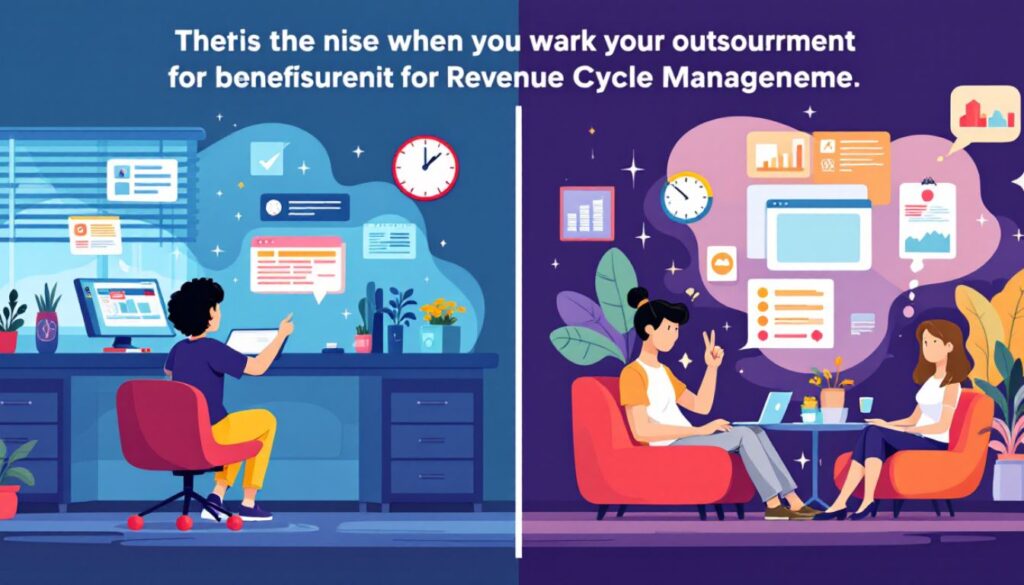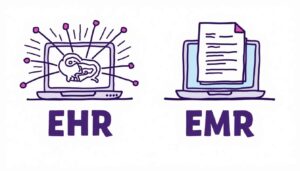Revenue Cycle Management Outsourcing vs In House: Which Is Best for Your Practice?
14 Oct 2025 By: Vlade Legaspi
Updated

In today’s fast-changing healthcare world, managing a practice’s finances is key. A core part of this is Revenue Cycle Management (RCM) — handling claims, payments, and income from patient care. Choosing Revenue Cycle Management Outsourcing vs In House can shape a practice’s speed, profit, and patient trust.
This guide shares the strengths and downsides of both methods, helping healthcare providers pick the best fit for their goals.
Understanding Revenue Cycle Management: The Backbone of Practice Finances

Revenue cycle management covers all those steps that handle grabbing, tracking, and pulling in money from patient services. You know, it goes from scheduling the appointments right up to sending bills to insurance companies and chasing down those payments. That way, providers end up getting their cash quicker and without all the headaches. Thing is, a lot of practices these days keep weighing revenue cycle management outsourcing vs in house options. They want to figure out whatever setup really ramps up their efficiency and brings in more profit.
The Medical Group Management Association (MGMA) notes that poor RCM can cause late payments, more denials, and lost income. Studies show providers may lose 20–30% of earnings due to billing mistakes and claim denials.
Given the complexity of coding, insurance regulations, and patient billing, managing RCM effectively demands expertise, technology, and constant monitoring.
Key Components of Revenue Cycle Management
RCM involves multiple stages, including:
- Patient Registration: Collecting demographic and insurance information.
- Insurance Verification: Confirming patient coverage and benefits.
- Charge Capture: Documenting services provided for billing.
- Claim Submission: Sending claims to payers accurately and timely.
- Payment Posting: Recording payments from insurers and patients.
- Denial Management: Identifying and resolving rejected claims.
- Patient Collections: Managing co-pays, deductibles, and outstanding balances.
Each step needs accuracy and teamwork, making RCM a vital yet complex part of any healthcare practice. Using tools like EHRs and automated billing speeds up the process. With data insights, providers can spot billing errors early and fix them fast. Training staff on coding and insurance rules also cuts costly mistakes, keeping revenue steady. Many compare Revenue Cycle Management Outsourcing vs In House to boost this accuracy and flow.
The patient experience now ties closely to RCM. As patients handle more costs, clear talk about prices and payment options matters most. Practices that stay open about billing and offer flexible plans raise both trust and payments. Involving patients builds loyalty and supports the practice’s financial strength.
The In-House RCM Model: Control and Customization

Many practices choose to handle their revenue cycle in-house, using skilled staff and custom or third-party tools. This method brings key benefits but also real hurdles.
Advantages of In-House RCM
1.) Greater Control and Oversight: In-house billing gives full control over revenue cycle tasks. This helps make fast changes and build workflows that fit the team best.
2.) Customization to Practice Needs: Internal teams shape billing for the practice’s needs. A pediatric clinic, for example, can use codes that fit children’s care.
3.) Immediate Communication: On-site staff talk directly with clinical teams. This cuts errors and answers patient questions fast, boosting trust and satisfaction.
These points show why many compare Revenue Cycle Management Outsourcing vs In House to find the best fit for control and service.
Challenges of In-House RCM
1.) High Operational Costs: In-house billing can cost $40K–$60K per employee yearly, not counting training or software. These costs pile up for smaller practices fast.
2.)Staffing and Training Burden: Finding and keeping skilled billing staff takes time and money. High turnover causes delays and adds extra work to your current team.
3.) Keeping Up with Regulatory Changes: Billing rules shift often. In-house teams must train nonstop to stay compliant and avoid denied claims or big penalties.
4.) Technology Investment: Billing software needs constant updates. Old systems slow work, cause errors, and make it hard to add new tools or track data right.
Is In-House RCM Right for Your Practice?
The in-house RCM model functions optimally for big practices which maintain enough resources to maintain a full-time billing department. The billing model suits practices that need customized billing solutions and want to maintain strict internal control systems. The high operational costs and complex management requirements of in-house RCM make it difficult for small practices to implement this system. Specialized firms that handle revenue cycle management offer practices a better solution because they deliver professional expertise without requiring them to maintain their own internal billing staff.
The selection of an in-house RCM system depends on evaluating practice requirements and available resources and future business objectives. The most suitable revenue cycle management approach depends on three main factors: patient volume and service complexity and current administrative systems. Medical practices that assess their operational needs will discover financial solutions which strengthen their financial stability while enabling them to maintain high-quality patient care.
Outsourcing RCM: Efficiency and Expertise at Scale

The practice partners with an external company that provides specialized services for billing and coding and collections management through revenue cycle management outsourcing. The model has become more popular because it helps organizations decrease expenses while enhancing their financial cash flow. The fast-changing healthcare environment with its quick-evolving payer rules and regulations makes RCM outsourcing essential for practices to stay adaptable while maintaining their core focus on patient care.
Benefits of Outsourcing RCM
1. Cost Savings. Outsourcing cuts overhead a lot. It gets rid of needing full time billing staff. You skip software licenses too. And training costs go away. A report from 2023 by Black Book Market Research showed something interesting. Seventy eight percent of healthcare providers who outsourced RCM had 15 to 20 percent lower administrative costs on average. Those savings let practices put money back in. Maybe upgrade medical equipment. Or make patient services better. Staff training programs could expand. All that helps improve care quality overall.
2. Access to Expertise. RCM vendors have specialists on board. These folks know coding inside out. They handle payer requirements well. Compliance is their thing too. That means fewer claim denials happen. Reimbursements come faster. Plus these professionals keep up with industry trends. Regulatory changes do not catch them off guard. Practices stay compliant that way. No costly penalties to worry about. This kind of knowledge helps practices a ton. Especially ones without resources for an in house team like that.
3. Advanced Technology. Outsourcing firms often use top notch software. Analytics tools come with it. Small practices could not afford that stuff alone. The tech boosts accuracy in billing. Financial reporting gets more insightful. Advanced analytics give real value. Practices see into their revenue cycle better. Trends pop up. Areas needing fixes show themselves. Traditional ways might miss all that. Data driven decisions follow. Operational efficiency improves. Financial health gets stronger too.
4. Scalability. With outsourcing practices scale billing easy. Up or down depending on patient volume. No hassle of hiring or laying off people. Flexibility works great for seasonal changes. Or sudden patient surges. Service levels stay optimal. Quality does not drop. Unnecessary costs avoid getting racked up.
5. Focus on Patient Care. Handing off admin tasks frees up providers. They concentrate on clinical care more. Patient experience improves that way. Satisfaction scores go up. Health outcomes get better. More time means understanding patient needs deeper. The care journey enhances overall.
Potential Drawbacks of Outsourcing
1. Reduced Control. Handing over billing to some outside firm cuts down on your direct watch over things. If their goals don’t line up with yours or if talking gets messy, problems pop up now and then. Practices end up struggling to make sure their own standards stick in those handled processes. That can mess with how patients feel about interactions and overall satisfaction.
2. Data Security Concerns. When you share patient details and money info with outsiders, you need strong safeguards and full HIPAA follow-through. Practices have to check out vendors really carefully. Make sure they’ve got tight rules for keeping data safe. This helps cut down risks from breaks or someone sneaking in without permission.
3. Vendor Dependence. Practices can get too tied to the vendors setup and ways of doing things. Switching or tweaking becomes a real hassle. That reliance opens up weak spots. Especially if the vendor hits snags in operations or if you need to rethink the partnership over how they perform.
4. Hidden Costs. Certain vendors tack on charges tied to what they collect or how much volume there is. Those fees build up fast unless you negotiate hard. Practices ought to dig deep in their homework. Set up solid contracts that spell out every possible expense. This keeps surprise money hits from showing up later.
Is Outsourcing RCM a Good Fit?
Outsourcing RCM Can Be a Good Fit. Thing is, it works well for smaller or medium practices wanting to ease up on admin work and boost cash coming in. No big starting costs either. It fits practices aiming to grab expert skills and tech without growing that stuff inside. Still, anyone thinking about it should look at their own setup and aims. Pick a vendor that matches their way of running things. One that backs long-term plans too. Going through a full check process helps decide smart. It strengthens revenue handling. Keeps the main eye on good patient care.
Comparing Financial Impacts: Cost Analysis of In-House vs. Outsourced RCM

Financial considerations are often the deciding factor when choosing between in-house and outsourced RCM. Let’s break down the key cost elements.
In-House Cost Components
- Staff Salaries and Benefits: Hiring coders, billers, and administrative staff.
- Training and Continuing Education: Keeping staff updated on coding changes and regulations.
- Software and IT Infrastructure: Purchasing and maintaining billing software, hardware, and security systems.
- Office Space and Equipment: Physical resources for the billing team.
- Opportunity Cost: Time spent managing billing internally that could be focused on patient care or growth.
Outsourcing Cost Components
- Vendor Fees: Typically charged as a percentage of collections (ranging from 4% to 10%) or a flat monthly fee.
- Implementation and Transition Costs: Initial setup, data migration, and training on new systems.
- Contract Management: Time and resources spent negotiating and overseeing vendor relationships.
A survey back in 2023 from the Healthcare Financial Management Association showed something interesting. Practices that outsource their RCM ended up with average yearly savings from $50,000 to $150,000. That’s when you compare it to keeping everything in-house with your own team. Revenue Cycle Management Outsourcing vs In House, you know. Still, those savings depend a lot on things like how big the practice is and the number of patients coming through. Vendor terms matter quite a bit too.
Impact on Patient Experience and Practice Efficiency

The choice on RCM, you know, goes beyond just money stuff. It affects how patients feel and how the whole operation runs day to day.
Patient Experience Considerations
Patient experience really hinges on stuff like straightforward billing and nailing it every time. That builds trust, you know. But when bills screw up or statements leave people scratching their heads, it just ticks them off. Payments drag on too, basically.
In house teams handling revenue cycle management outsourcing vs in house, they bring that personal vibe to patient chats. Sometimes they clear up billing snags way quicker. Still, if the outsourcing outfit runs smooth, they roll out dedicated patient help lines. Oh and those online portals, they open everything up more.
Operational Efficiency
People talk about revenue cycle management outsourcing vs in house all the time. On the operations side, outsourcing just smooths things out in the workflow, you know. They bring in automation and real experts who know the ropes. It really cuts back on those denied claims and gets the cash flowing faster. In house teams, they run into problems though. Like when staffing gets thin or during all that training. Stuff piles up.
In the end, efficiency boils down to the folks involved, the technology they have, and overall management. Basically no matter the path you pick.
Compliance and Risk Management: Navigating Regulatory Complexities

Healthcare billing comes with a bunch of regulations, you know. In revenue cycle management outsourcing vs in house setups, those strict rules hit hard from Medicare, Medicaid, and private insurers. Don’t comply, and audits start rolling in. Fines build up fast. Your reputation gets wrecked pretty quick.
In-House Compliance Challenges
Staying compliant takes constant effort. You end up learning all the time, you know. That covers things like internal audits. And tweaking those billing methods whenever it is needed. Practices have to put real money into training the staff. They should hire compliance officers as well. All of this ties into Revenue Cycle Management Outsourcing vs In House choices. It really cuts down on risks in a big way.
Advantages of Outsourcing for Compliance
Those specialized vendors for Revenue Cycle Management Outsourcing vs In House usually bring their own compliance teams along. They got solid processes in place too. That sort of thing keeps them pretty much up to date on all the regulations out there. And yeah, because they are bigger operations, they can handle more advanced ways to manage those risks.
Still, practices cant just assume everything is all good. They have to check that these vendors are sticking to HIPAA and all the other rules. Do some thorough due diligence on them. Put in strong safeguards right there in the contracts.
Making the Decision: Factors to Consider for Your Practice

The thing is, when you look at revenue cycle management outsourcing vs in house, it all comes down to factors that fit each practice just right. You know, nothing’s one size fits all here.
Practice Size and Patient Volume
Practice size and patient volume play a big role in revenue cycle management outsourcing vs in house decisions. Bigger setups that handle tons of patients, they usually go with in house teams. Keeps things under tight control that way. They can tweak processes to fit exactly what they need. Smaller practices though. They lean toward outsourcing a lot. Its cheaper overall. Doesn’t pile on as much work either.
Financial Resources and Budget Constraints
Thing is, when comparing revenue cycle management outsourcing vs in house, financial resources and budget stuff really matter. You need to dig into the total costs for both options. That includes spotting those hidden fees along the way. And figuring out what you might lose otherwise. Budgets can catch you off guard. If you are not paying close attention.
Technology and Infrastructure
Technology and infrastructure play in big. See what IT you’ve got now. Then figure if you’re up for spending on updates or whole new setups. Sometimes that investment just isn’t worth it, you know.
Staffing and Expertise
Staffing and expertise, that’s another angle. Do you even have skilled billing folks around. And can you handle the constant training or people leaving all the time. It’s a real drag if turnover hits hard.
Compliance and Risk Appetite
Compliance and risk, yeah. Gauge how okay you are with rules and regs risks. Plus if your team can deal with audits and staying compliant on their own. Not everyone wants that headache internally.
Patient Experience Priorities
Patient experience priorities matter too. Billing messes can bug patients quick. So decide if you want hands on control or let a vendor specialist handle it. Either path affects how folks feel about the whole thing.
Case Studies: Real-World Examples of RCM Decisions

Case Study 1: A Mid-Sized Orthopedic Practice
This practice had a tough time with slow reimbursements and lots of denied claims from their in-house setup. Thing is, they switched over to revenue cycle management outsourcing vs in house option with a specialized RCM vendor. That cut denials down by 25 percent right away. Cash flow got better by 18 percent in the first year too. The vendor used some advanced analytics stuff. It helped spot coding mistakes and made claims submission smoother overall.
Case Study 2. A Large Multi-Specialty Group.
They had more than 50 providers handling things. Kept an in-house RCM team for custom workflows. Made sure it tied in close with the clinical staff, you know. Put a ton of money into training and tech upgrades. Ended up with a 95 percent first-pass acceptance rate on claims. Internal folks also handled patient billing quick. Boosted satisfaction levels quite a bit.
Case Study 3. A Small Primary Care Practice.
Administrative costs kept climbing for them. So they went with outsourcing RCM to a vendor that had bundled pricing deals. Cut overhead by 30 percent that way. Freed up the doctors to spend more time on patients instead. Had some worries at first about losing control. But regular meetings with the vendor and clear reporting kept everything aligned. Trust stayed solid.
Trending Now!
People still talk about how the Revenue Cycle Management Outsourcing vs In House debate plays out in healthcare these days. The whole RCM market keeps growing fast. It went from about 136.7 billion dollars back in 2020. Now its headed to double that, right up to 286.7 billion by 2028. Hospitals and doctor offices mostly handle things in house still. But outsourcing makes up around 10% to 15% of it all. And that part looks set to expand a lot more soon.
Outsourcing can be just some parts or the full deal. You keep different amounts of control either way. And yeah, you hold onto your own knowledge about the place. What pushes folks toward it includes better cash coming in quicker. Operations run smoother too. Costs to collect drop down. Patients end up happier with the process. Plus there are labor shortages hitting hard. And tech like AI and robotic process automation gets mixed in to help.
Providers lean on clearinghouses a bunch. That keeps claims clean. Billing gets optimized that way.
Still, outsourcing has its downsides you know. Managing the vendor right is key to making it work. But a lot of places arent really set up for that extra work. It adds overhead. Problems pop up like vendors not performing well enough. Transparency can be lacking sometimes. Transitions cause headaches. Even if you outsource only part of it.
All the same, it can help your internal team out strategically. They handle the low priority stuff. Staff gets freed up for the big important tasks. When you do the hybrid model good, cash flow speeds up in 30 to 60 days. Over time revenue improves too. Through handling denials better. And cutting down on that old accounts receivable.
Conclusion: Tailoring Your RCM Strategy for Success
Revenue cycle management is one of those things that really hits the financial side of healthcare practices hard. You know, it keeps everything running smooth or not. Now, when it comes to Revenue Cycle Management Outsourcing vs In House, each way has its own upsides and headaches.
Doing it in-house gives you full control, lets you tweak things just how you want. But it takes a ton of money upfront for hiring people, getting the right tech, staying on top of all those rules. Still, that’s the trade-off.
Outsourcing, on the other hand, cuts down on costs pretty quick. You get experts who know their stuff, and things run more efficient overall. Thing is, you lose some of that hands-on watch, and you’re stuck relying on whoever you pick as your vendor. Not always ideal.
So yeah, picking between Revenue Cycle Management Outsourcing vs In House really boils down to how big your practice is, what resources you’ve got, your main goals, how much risk you can handle. Oh and, a hybrid setup could work too. Keep some oversight inside, outsource the tricky parts.
In the end, look close at what your practice needs, what you’re aiming for. That way, you set up an RCM plan that pulls in more revenue, makes patients happier, keeps growth going strong.
Choosing between Revenue Cycle Management Outsourcing vs In House isn’t one-size-fits-all—it depends on your practice’s size, resources, and goals. Whether you prioritize control or efficiency, or you’re exploring a hybrid approach, the key is aligning your RCM strategy with your long-term vision.
At HelpSquad Health, we understand the unique needs of healthcare providers. Join us to streamline your revenue cycle, boost cash flow, and enhance patient satisfaction—with expert support every step of the way.


